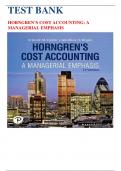Examen
Test Bank Horngren's Cost Accounting 17th Edition by Srikant M. Datar|9780136713845| All Chapters 1-23|LATEST
- Grado
- Institución
Test Bank Horngren's Cost Accounting 17th Edition by Srikant M. Datar|9780136713845| All Chapters 1-23|LATEST
[Mostrar más]



